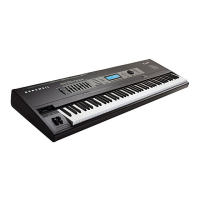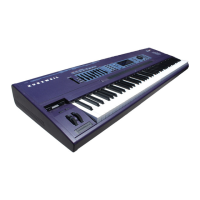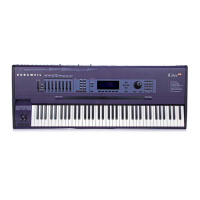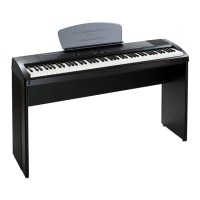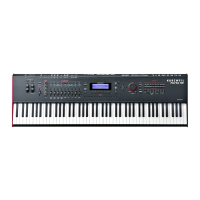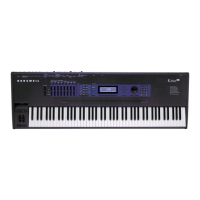9-2
Effects and Effect Mode
Effects Overview
Master Effects
After the signal goes through the Insert and Aux eects, the master EQ/compressor eects are
applied globally to the signal at the main outputs. Neither the EQ nor the Compressor use up any
DSP units, so you needn’t account for them when managing DSP units for eects processing
power. See TheMasterEectsPage on page 9-8 for details.
Chains
The object used for Insert and Aux Eects is referred to as a “Chain.” A Chain contains a single
eect-box or is a series of connected eect-boxes. Each program can have one main Insert Chain,
or individual layers within a program can have their own Insert Chain that will be used instead
of the program’s main Insert Chain. Programs, Setups and Songs can each have two Aux Chains.
You can select from the same set of Chains to use for both Aux and Insert Eects. (Up 11 Insert
Chains and two Aux Chains can be active at a time, depending on DSP unit usage, see DSP Units -
ManageandDistributeProcessorPowerforEects on page 9-3 for details.)
Signal Flow
When using eects, it is important to understand how your signal is being processed. For each
Program, zone, or track, your signal can be sent to the Aux eects before or after being processed
by the Program’s Insert eects. The diagram below is for a program that does not use layer-
specic eects, showing the possible routes that the signal of a program can “ow” through to
reach the dierent types of eects. Follow the appropriate route to help visualize the stages in
which the signal is being processed. A circle with an arrow through it shows a point where the
signal level can be adjusted. Dashed lines indicate dierent routes that the signal can ow (based
on the Aux pre/post settings and Master FX Order settings. A circled sigma (S) shows where
signals are mixed together.
When using eects, the rst decision to make is whether you want to use an Insert or Aux eect
(see the InsertEects and AuxEects sections above.) If you are using both types of eects for a
program, zone, or track in Song Mode, you can choose to have your signal sent to the Aux eects
before or after being processed by the Insert eects. (See Send Levels and Pre/Post Ins. on page 9-7
for details.) When your signal is sent to the Aux Eects after being processed by the Program’s
Insert Eects, this is called applying the Aux Eect post-Insert. When your signal is sent to the
Aux Eects before being processed by the Program’s Insert Eects, this is called applying the Aux
Eect pre-Insert.
When an Aux Eect is applied post-Insert, the wet (processed) Aux signal has a series of eects
applied to it—i.e., cascaded eects. This means that the signal that is blended back in from the
result of the Aux Eect will also contain the result of the Insert Eect.
When an Aux Eect is applied pre-Insert, the wet Aux signal has no Insert eect applied to it,
and the nal output has parallel eects—i.e., distinct eects. This means that the signal that is
blended back in from the result of the Aux Eect will not contain the result of the Insert Eect.
Comp EQ
AUX 2 Chain
Insert
Program
AUX 1 Chain
Pre
Post
Send Levels
S
EQ Comp
Output
Chain
Master FX Order

